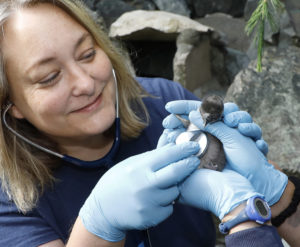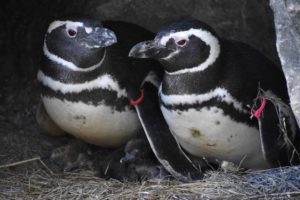
June UPDATE: Our penguin chicks are now behind-the-scenes, learning to swim. Yes, you read that right. While their downy feathers stiffen and become more waterproof, they’ll live in temporary quarters away from the big pool at Penguin Point. Staff biologists will keep a keen eye on them as they learn to swim in a smaller pool. They’re also learning to be hand-fed by keepers so they can get their proper diet as they grow. They’ll rejoin the rest of the colony in a few weeks.
May 31, 2018: Four penguin chicks have hatched! After sitting on eggs all month, two parent couples Pink and Red and Yellow and Orange (we call them by the colored ID bands on their wings) have baby chicks to care for.
Keepers and head veterinarian Dr. Karen Wolf did a well-chick exam, and found all chicks in excellent health.
Now it’s up to the parents. Staff biologist Amanda Shaffer reports that the parents are doing a great job taking turns brooding the chicks, feeding them regurgitated fish (yum!) and keeping them warm with a special abdomen patch that allows skin-to-skin contact.

Visitors might be able to spot the fluffy chicks – or they might not. They’ll mostly stay tucked away under Mom and Dad, keeping warm and sleeping.
Magellanic penguins are medium-sized birds that weigh around 10 pounds as adults. They’re native to the South American coasts of Chile, Argentine, Uruguay and Brazil. Four of our penguins were rescued after washing ashore in South America. Four were hatched here, and one was hatched at Blank Park Zoo in Iowa.
They’re a near-threatened species, threatened in the wild by plastic ocean trash, oil spills and overfishing.